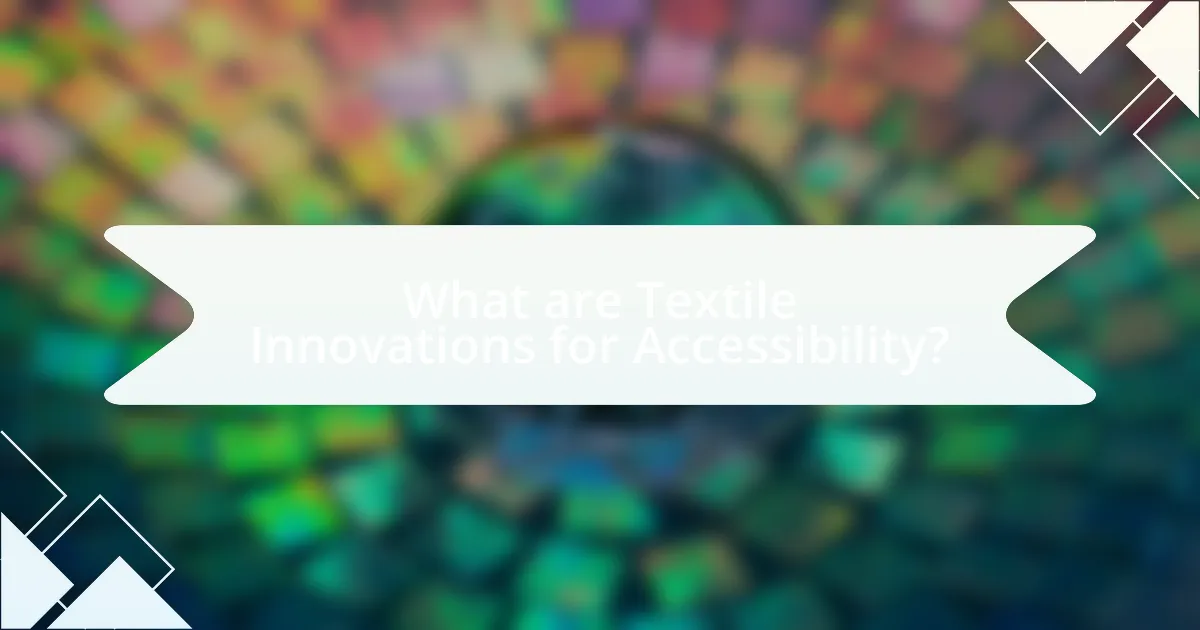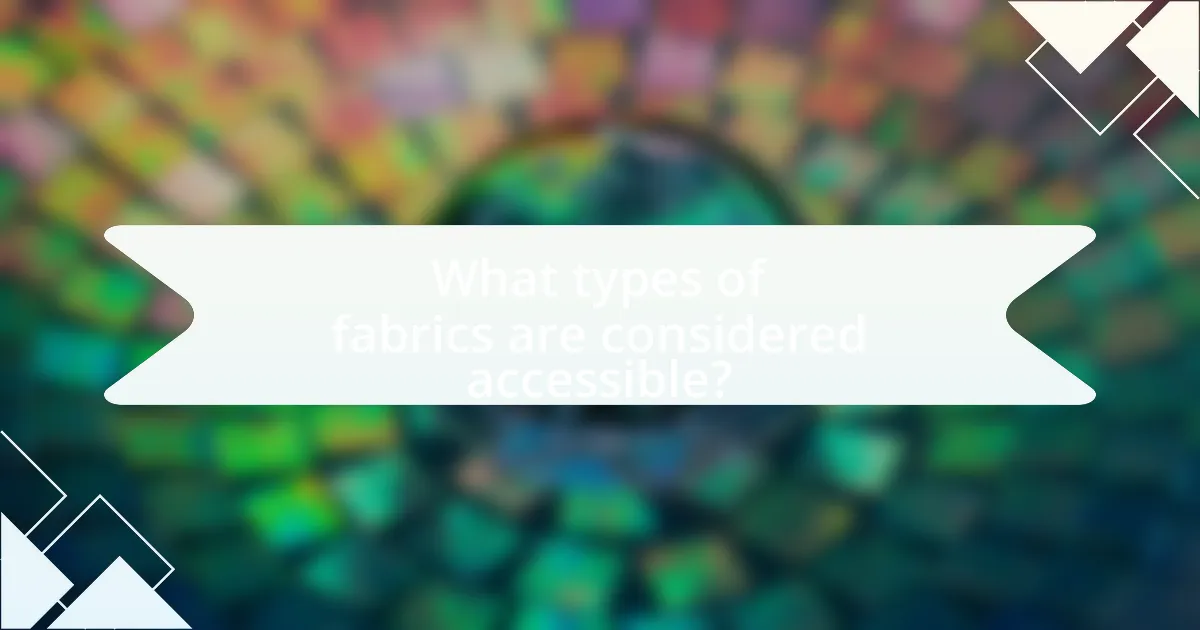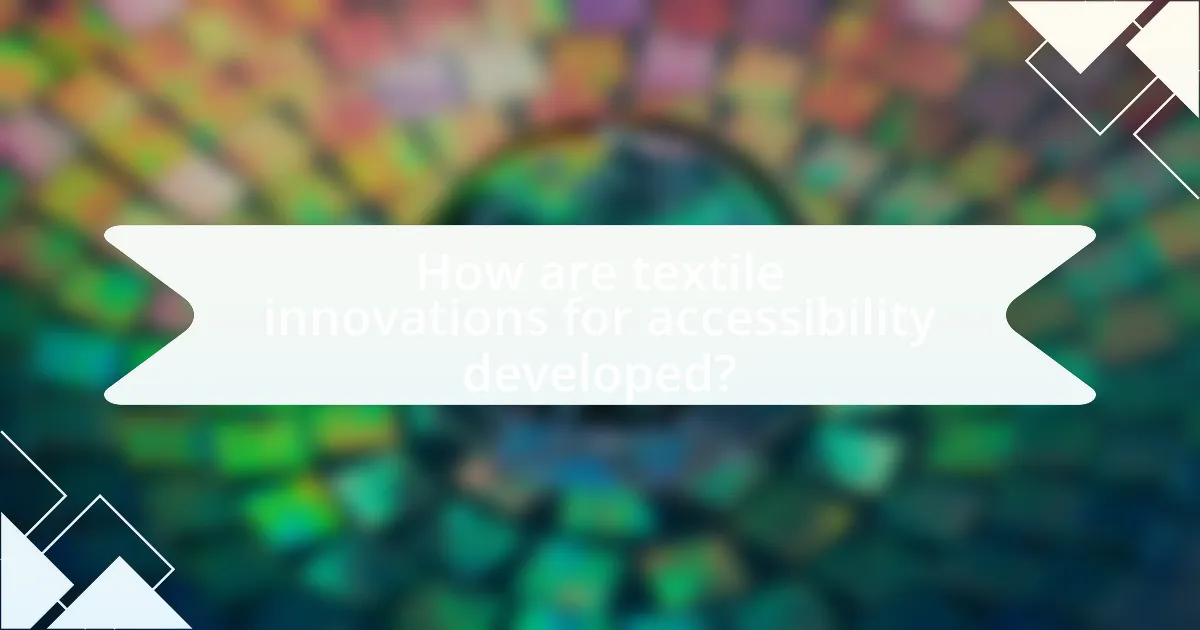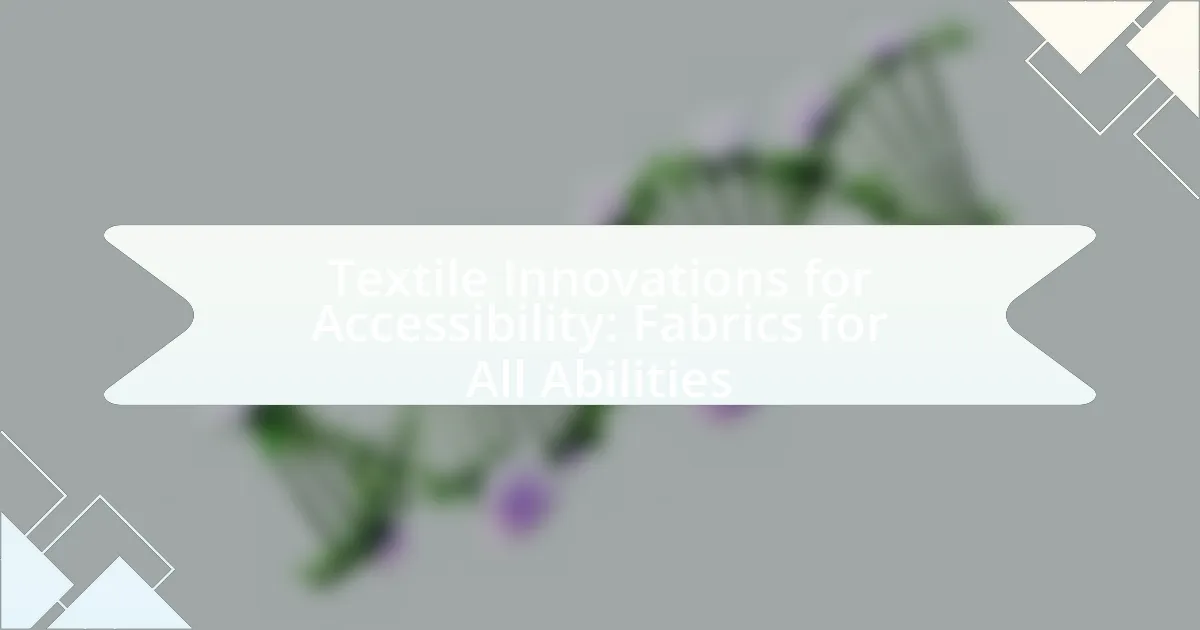Textile innovations for accessibility focus on advancements in fabric technology aimed at improving usability for individuals with disabilities. These innovations include adaptive clothing that accommodates mobility aids, sensory-friendly fabrics, and smart textiles that monitor health conditions. The article explores how these innovations enhance the quality of life by addressing specific needs, promoting independence, and increasing social participation. It also discusses the importance of inclusive design principles, the challenges faced by individuals with disabilities in traditional textiles, and future trends in sustainable and customizable accessible textiles.

What are Textile Innovations for Accessibility?
Textile innovations for accessibility refer to advancements in fabric technology designed to enhance usability for individuals with disabilities. These innovations include features such as adaptive clothing that accommodates mobility aids, fabrics with built-in sensory elements for individuals with sensory processing disorders, and textiles that incorporate smart technology for monitoring health conditions. For instance, companies like Tommy Hilfiger and Nike have developed adaptive clothing lines that provide easier dressing options for people with limited dexterity. Additionally, research indicates that the global adaptive clothing market is projected to grow significantly, reflecting the increasing demand for inclusive fashion solutions.
How do these innovations impact individuals with disabilities?
Textile innovations significantly enhance the quality of life for individuals with disabilities by providing adaptive clothing solutions that improve comfort, functionality, and independence. For instance, fabrics designed with stretchability and moisture-wicking properties cater to individuals with mobility challenges, allowing for easier dressing and undressing. Additionally, innovations such as magnetic closures and tagless designs reduce the difficulty faced by those with dexterity issues, promoting self-sufficiency. Research indicates that adaptive clothing can lead to increased confidence and social participation among individuals with disabilities, as it addresses specific needs while maintaining style and personal expression.
What specific needs do these textiles address?
Textiles designed for accessibility address the specific needs of individuals with disabilities by enhancing comfort, functionality, and independence. These textiles often incorporate features such as stretchability, moisture-wicking properties, and easy-care materials, which cater to the physical limitations and sensory sensitivities of users. For instance, adaptive clothing made from soft, non-irritating fabrics minimizes discomfort for individuals with tactile sensitivities, while garments with magnetic closures facilitate dressing for those with limited dexterity. Research indicates that such innovations significantly improve the quality of life for users by promoting greater autonomy and self-expression in their daily activities.
How do these innovations enhance daily living for users?
Textile innovations for accessibility enhance daily living for users by providing adaptive fabrics that cater to diverse needs, improving comfort, functionality, and independence. For instance, smart textiles can monitor health metrics, allowing users to manage conditions more effectively, while easy-care fabrics reduce maintenance efforts for individuals with limited mobility. Additionally, inclusive designs, such as adjustable clothing, empower users by promoting self-dressing capabilities. Research indicates that these innovations lead to increased quality of life and greater participation in daily activities, as evidenced by studies showing that adaptive clothing significantly boosts confidence and social engagement among individuals with disabilities.
Why is accessibility important in textile design?
Accessibility is important in textile design because it ensures that fabrics can be used by individuals with diverse abilities, promoting inclusivity. By incorporating features such as adaptive sizing, tactile elements, and easy-care materials, designers can create textiles that cater to the needs of people with disabilities. Research indicates that approximately 15% of the global population experiences some form of disability, highlighting the necessity for accessible design in textiles to enhance usability and comfort for this significant demographic.
What are the challenges faced by individuals with disabilities in traditional textiles?
Individuals with disabilities face significant challenges in traditional textiles, primarily due to the lack of adaptive designs and accessibility features. Traditional textiles often do not accommodate the specific needs of individuals with mobility impairments, sensory sensitivities, or cognitive disabilities, making it difficult for them to use or wear these fabrics comfortably. For instance, clothing may have fasteners that are hard to manipulate, or fabrics may not provide the necessary sensory comfort for those with tactile sensitivities. Additionally, the absence of inclusive sizing and styles can limit choices for individuals with disabilities, further exacerbating their difficulties in finding suitable clothing.
How can inclusive design principles be applied to textiles?
Inclusive design principles can be applied to textiles by ensuring that fabrics and garments accommodate a diverse range of physical abilities and sensory needs. This can involve using adaptive features such as adjustable closures, tagless labels, and sensory-friendly materials that minimize irritation for individuals with tactile sensitivities. Research indicates that approximately 15% of the global population lives with some form of disability, highlighting the necessity for textiles that cater to these individuals. By incorporating feedback from users with disabilities during the design process, textile manufacturers can create products that enhance usability and comfort, thereby promoting inclusivity in fashion and everyday wear.

What types of fabrics are considered accessible?
Accessible fabrics include those that are easy to manipulate, comfortable to wear, and adaptable for various needs, such as cotton, jersey, and stretchable materials. Cotton is widely recognized for its softness and breathability, making it suitable for individuals with sensitive skin. Jersey fabric offers stretch and flexibility, allowing for ease of movement, which is beneficial for people with mobility challenges. Additionally, fabrics with features like moisture-wicking properties or easy closures enhance accessibility for users with different abilities. These characteristics ensure that the fabrics cater to a diverse range of physical needs and preferences.
How do adaptive fabrics differ from conventional fabrics?
Adaptive fabrics differ from conventional fabrics primarily in their ability to respond to the wearer’s needs, enhancing comfort and functionality. While conventional fabrics are typically static in their properties, adaptive fabrics incorporate technologies such as moisture-wicking, temperature regulation, and stretchability, which allow them to adjust to various conditions and user requirements. For example, adaptive fabrics may include features like magnetic closures or adjustable fits, making them easier for individuals with disabilities to wear. This adaptability is supported by advancements in textile engineering, which have led to the development of materials that can change their properties based on environmental stimuli or user interaction.
What materials are commonly used in adaptive textiles?
Common materials used in adaptive textiles include cotton, polyester, nylon, spandex, and specialized fibers like conductive yarns and phase change materials. Cotton is favored for its softness and breathability, while polyester and nylon provide durability and moisture-wicking properties. Spandex is often incorporated for stretchability, enhancing comfort and fit. Conductive yarns enable smart textile applications, allowing for integration with technology, and phase change materials help regulate temperature, improving user comfort. These materials collectively enhance the functionality and accessibility of textiles for individuals with varying needs.
How do these materials contribute to comfort and usability?
Textile innovations for accessibility enhance comfort and usability through the integration of adaptive materials that cater to diverse needs. These materials, such as moisture-wicking fabrics, stretchable textiles, and soft-touch finishes, provide a comfortable wearing experience by regulating temperature, allowing freedom of movement, and minimizing skin irritation. For instance, moisture-wicking fabrics draw sweat away from the body, keeping users dry and comfortable, which is particularly beneficial for individuals with mobility challenges who may experience discomfort from prolonged wear. Additionally, stretchable textiles accommodate various body shapes and sizes, ensuring a better fit and ease of use for all individuals.
What are some examples of innovative accessible textiles?
Innovative accessible textiles include smart fabrics, which integrate technology to enhance usability for individuals with disabilities. For example, conductive textiles allow for touch-sensitive interfaces, enabling users to control devices through fabric. Additionally, adaptive clothing made from stretchable and breathable materials accommodates various body types and mobility challenges. Research by the University of Cambridge highlights the development of textiles that change color or texture in response to environmental stimuli, improving visibility and safety for users. These innovations demonstrate a commitment to inclusivity in textile design.
How do smart textiles enhance accessibility?
Smart textiles enhance accessibility by integrating technology that responds to the needs of individuals with disabilities. These textiles can include features such as temperature regulation, moisture management, and sensory feedback, which cater to specific requirements, making clothing more comfortable and functional. For instance, textiles embedded with sensors can alert caregivers in case of a fall or health issue, thereby improving safety and independence for users. Additionally, smart textiles can be designed to adapt to various physical conditions, such as providing compression for individuals with circulatory issues or offering adjustable fits for those with mobility challenges. This adaptability not only promotes inclusivity but also empowers users by enhancing their ability to engage in daily activities.
What role do sensory-friendly fabrics play in accessibility?
Sensory-friendly fabrics play a crucial role in accessibility by providing comfort and reducing sensory overload for individuals with sensory processing disorders, autism, or other sensitivities. These fabrics are designed to be soft, non-irritating, and often feature seamless construction to minimize discomfort. Research indicates that the use of such materials can significantly enhance the quality of life for individuals who experience heightened sensitivity to textures, as they allow for greater participation in daily activities and social interactions. For instance, a study published in the Journal of Autism and Developmental Disorders found that clothing made from sensory-friendly fabrics improved comfort levels and reduced anxiety in children with autism, thereby supporting their overall well-being and inclusion in various environments.

How are textile innovations for accessibility developed?
Textile innovations for accessibility are developed through a collaborative process involving designers, engineers, and users with disabilities. This development process often includes user-centered design principles, where feedback from individuals with varying abilities informs the creation of functional and adaptive textiles. For instance, research conducted by the University of Cambridge highlights the importance of integrating assistive technologies into fabric design, ensuring that textiles not only meet aesthetic standards but also enhance usability for people with disabilities. Additionally, advancements in materials science, such as the use of smart textiles that respond to environmental stimuli, further contribute to creating accessible solutions.
What research and technology drive these innovations?
Research and technology driving innovations in textile accessibility include advancements in smart textiles, adaptive fabric technologies, and inclusive design methodologies. Smart textiles, such as those developed by researchers at MIT’s Media Lab, integrate sensors and actuators to enhance functionality for individuals with disabilities. Adaptive fabric technologies, like those created by companies such as Nike and Under Armour, utilize stretchable and breathable materials to accommodate various body types and mobility needs. Inclusive design methodologies, as outlined in the work of the Design Council, emphasize user-centered approaches that involve individuals with disabilities in the design process, ensuring that the resulting fabrics meet diverse accessibility requirements.
How do collaborations between designers and users shape product development?
Collaborations between designers and users significantly shape product development by ensuring that the final products meet the actual needs and preferences of the end-users. This interaction allows designers to gather valuable insights directly from users, which can lead to more functional and accessible designs. For instance, in the context of textile innovations for accessibility, user feedback can inform the selection of materials, patterns, and functionalities that cater to diverse abilities. Research has shown that user-centered design approaches, which involve users throughout the design process, result in products that are not only more effective but also more widely accepted by the target audience. This collaborative process enhances innovation and ensures that the products are practical and relevant, ultimately leading to greater user satisfaction and market success.
What role does user feedback play in the design process?
User feedback is crucial in the design process as it directly informs and shapes product development to meet user needs. In the context of textile innovations for accessibility, user feedback helps designers understand the specific requirements and preferences of individuals with varying abilities, ensuring that fabrics are functional, comfortable, and inclusive. For instance, studies have shown that incorporating user insights can lead to a 30% increase in user satisfaction and usability in product design, highlighting the importance of feedback in creating effective solutions.
What are the future trends in accessible textiles?
Future trends in accessible textiles include the integration of smart technology, sustainable materials, and customizable designs. Smart textiles, which incorporate sensors and responsive elements, enhance usability for individuals with disabilities by providing real-time feedback and assistance. Sustainable materials, such as recycled fibers and organic fabrics, are gaining traction as consumers demand eco-friendly options that also cater to diverse needs. Customizable designs allow for personalized fits and functionalities, ensuring that textiles meet the specific requirements of various users. These trends are supported by research indicating a growing market for adaptive clothing, projected to reach $400 billion by 2026, highlighting the increasing demand for inclusivity in fashion and textiles.
How is sustainability being integrated into accessible textile innovations?
Sustainability is being integrated into accessible textile innovations through the use of eco-friendly materials and processes that prioritize both environmental responsibility and inclusivity. Companies are increasingly adopting organic cotton, recycled polyester, and biodegradable fibers to create textiles that are not only sustainable but also designed for diverse needs, such as adaptive clothing for individuals with disabilities. For instance, brands like Tommy Hilfiger and Nike have launched collections that incorporate sustainable practices while ensuring ease of wear for people with varying abilities, demonstrating a commitment to both sustainability and accessibility.
What advancements in technology are expected to influence future designs?
Advancements in technology expected to influence future designs in textile innovations for accessibility include smart fabrics, 3D printing, and wearable technology. Smart fabrics integrate sensors and electronics, enabling features like temperature regulation and health monitoring, which enhance user experience and functionality. 3D printing allows for customized textile designs that cater to individual needs, promoting inclusivity in fashion. Wearable technology, such as garments that assist with mobility or communication, further supports diverse abilities. These technologies collectively aim to create fabrics that are not only functional but also adaptable to various user requirements, thereby improving accessibility in textile design.
What best practices should be followed in creating accessible textiles?
To create accessible textiles, designers should prioritize inclusive design principles, ensuring that fabrics accommodate a wide range of physical abilities and sensory needs. This includes using adaptive features such as adjustable fastenings, tagless labels, and easy-to-manipulate closures that enhance usability for individuals with limited dexterity. Additionally, selecting materials that are soft, breathable, and hypoallergenic can improve comfort for users with sensory sensitivities. Research indicates that incorporating feedback from individuals with disabilities during the design process leads to more effective and user-friendly textile solutions, as evidenced by studies highlighting the importance of user-centered design in product development.

Leave a Reply